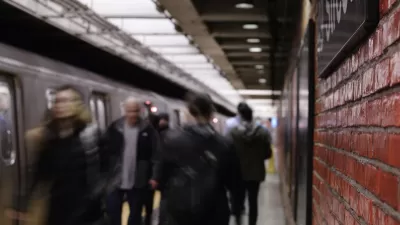A coalition of community groups claims that current plans are designed to benefit developers and don’t guarantee improvements for transit riders.

Penn Station’s long-awaited redevelopment hit another snag as several citizen groups filed a lawsuit against Empire State Development and the New York State Public Authorities Control Board, claiming that the agencies did not conduct a proper environmental review and “improperly” entered a revenue-sharing agreement with the city. Colleen Wilson reports on the case for NorthJersey.com.
“At issue is the more than 18 million square feet of commercial, residential and hotel space proposed on properties in the immediate vicinity of Penn Station.” Revenue from these projects is meant to fund other improvements to the station area, such as additional tracks, new entrances and elevators, and a new pedestrian corridor, but the plaintiffs in the suit say “there's "no basis" for ESD's claim that it would generate the revenue needed to fund New York's share of station projects.”
As Wilson explains, the historic station has become a notorious choke point in New York’s public transportation system. “The now-54-year-old structure was designed to handle 200,000 people a day, but for at least two decades it has operated over capacity, with as many as 650,000 people using the station daily in 2019.”
See the source article for more details on the lawsuit and how it could affect the redevelopment plans.
FULL STORY: Giving us mediocrity:' Penn Station remodel controversy lands in court

Study: Maui’s Plan to Convert Vacation Rentals to Long-Term Housing Could Cause Nearly $1 Billion Economic Loss
The plan would reduce visitor accommodation by 25,% resulting in 1,900 jobs lost.

North Texas Transit Leaders Tout Benefits of TOD for Growing Region
At a summit focused on transit-oriented development, policymakers discussed how North Texas’ expanded light rail system can serve as a tool for economic growth.

Why Should We Subsidize Public Transportation?
Many public transit agencies face financial stress due to rising costs, declining fare revenue, and declining subsidies. Transit advocates must provide a strong business case for increasing public transit funding.

How to Make US Trains Faster
Changes to boarding platforms and a switch to electric trains could improve U.S. passenger rail service without the added cost of high-speed rail.

Columbia’s Revitalized ‘Loop’ Is a Hub for Local Entrepreneurs
A focus on small businesses is helping a commercial corridor in Columbia, Missouri thrive.

Invasive Insect Threatens Minnesota’s Ash Forests
The Emerald Ash Borer is a rapidly spreading invasive pest threatening Minnesota’s ash trees, and homeowners are encouraged to plant diverse replacement species, avoid moving ash firewood, and monitor for signs of infestation.
Urban Design for Planners 1: Software Tools
This six-course series explores essential urban design concepts using open source software and equips planners with the tools they need to participate fully in the urban design process.
Planning for Universal Design
Learn the tools for implementing Universal Design in planning regulations.
City of Santa Clarita
Ascent Environmental
Institute for Housing and Urban Development Studies (IHS)
City of Grandview
Harvard GSD Executive Education
Toledo-Lucas County Plan Commissions
Salt Lake City
NYU Wagner Graduate School of Public Service





























